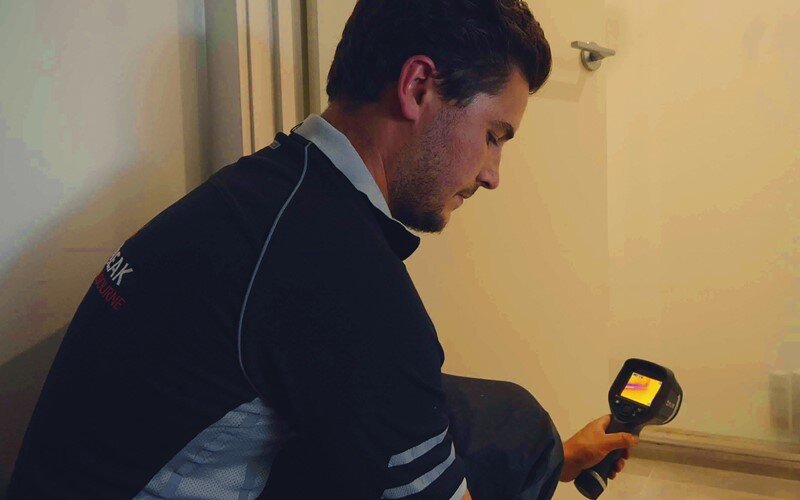Unmask Hidden Water Line Leaks: 6 Clever Detection Hacks
Unmask Hidden Water Line Leaks: 6 Clever Detection Hacks
Blog Article
Were you searching for tips about Locating water leaks?

Early discovery of dripping water lines can reduce a possible catastrophe. Some small water leakages might not be noticeable.
1. Analyze the Water Meter
Inspecting it is a surefire means that helps you find leakages. If it moves, that shows a fast-moving leakage. This implies you might have a slow-moving leak that could even be below ground.
2. Examine Water Consumption
Examine your water costs and track your water intake. As the one paying it, you should see if there are any type of discrepancies. If you find sudden changes, in spite of your intake being the same, it implies that you have leaks in your plumbing system. Keep in mind, your water bill ought to fall under the exact same range on a monthly basis. A sudden spike in your expense suggests a fast-moving leak.
A consistent boost every month, even with the very same behaviors, shows you have a slow-moving leakage that's also gradually rising. Call a plumber to thoroughly inspect your building, especially if you feel a warm location on your flooring with piping below.
3. Do a Food Coloring Examination
When it comes to water usage, 30% comes from commodes. If the color in some way infiltrates your dish during that time without flushing, there's a leak between the storage tank and dish.
4. Asses Exterior Lines
Don't fail to remember to inspect your exterior water lines as well. Test faucets by connecting a yard hose pipe. Ought to water seep out of the connection, you have a loosened rubber gasket. Replace this as well as guarantee all links are limited. It will certainly help obtain it skillfully checked out and preserved each year if you have actually got a sprinkler system. One small leak can squander lots of water and surge your water expense.
5. Examine the situation and also inspect
Homeowners ought to make it a habit to check under the sink counters and also even inside cabinets for any kind of bad odor or mold development. These two red flags suggest a leakage so prompt interest is called for. Doing routine examinations, even bi-annually, can conserve you from a significant problem.
If you recognize your house is already old, maintain a careful eye on your heating systems, hoses, pipelines and so on. Look for stainings as well as deteriorating as a lot of pipes and appliances have a life expectancy. They will also naturally deteriorate due to damage. Don't wait for it to intensify if you think dripping water lines in your plumbing system. Call an expert plumber right now so you do not end up with a dreadful mess in your home.
Early detection of leaking water lines can mitigate a prospective catastrophe. Some small water leaks may not be noticeable. Examining it is a surefire method that helps you discover leakages. One tiny leak can lose bunches of water and surge your water costs.
If you presume leaking water lines in your plumbing system, don't wait for it to escalate.
WARNING SIGNS OF WATER LEAKAGE BEHIND THE WALL
PERSISTENT MUSTY ODORS
As water slowly drips from a leaky pipe inside the wall, flooring and sheetrock stay damp and develop an odor similar to wet cardboard. It generates a musty smell that can help you find hidden leaks.
MOLD IN UNUSUAL AREAS
Mold usually grows in wet areas like kitchens, baths and laundry rooms. If you spot the stuff on walls or baseboards in other rooms of the house, it’s a good indicator of undetected water leaks.
STAINS THAT GROW
When mold thrives around a leaky pipe, it sometimes takes hold on the inside surface of the affected wall. A growing stain on otherwise clean sheetrock is often your sign of a hidden plumbing problem.
PEELING OR BUBBLING WALLPAPER / PAINT
This clue is easy to miss in rooms that don’t get much use. When you see wallpaper separating along seams or paint bubbling or flaking off the wall, blame sheetrock that stays wet because of an undetected leak.
BUCKLED CEILINGS AND STAINED FLOORS
If ceilings or floors in bathrooms, kitchens or laundry areas develop structural problems, don’t rule out constant damp inside the walls. Wet sheetrock can affect adjacent framing, flooring and ceilings.
https://www.servicemasterbyzaba.com/blog/how-to-detect-water-leakage-in-walls/

We hope you liked our piece about Leaking water lines. Thank you for spending some time to read our post. Enjoyed reading our piece of writing? Please share it. Let somebody else check it out. I truly appreciate reading our article about Detecting hidden plumbing leaks.
Need assistance? Call. Report this page